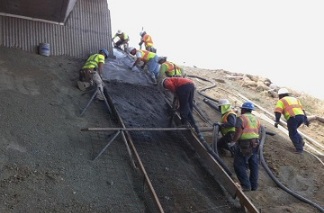Introduction
Pouring concrete on a sloped surface needs good skills and experience to perform the work as planned. Commonly, low slump concrete is used for sloped concrete members, driveways, and wheelchair ramps.
Low slump concrete is used for the inclined members.
Some examples of slope members are staircase, ramp, etc.

The placement of low slump concrete in its final position and compaction requires great caution, experience, and proper concreting procedures. That is why all the necessary preparation should be made before the commencement of pouring.
To place low slump concrete in its final position requires a very specific concreting procedure.
Here, I have described a complete procedure of concrete pouring on a sloped surface.
How to pour concrete on sloped surface?
First, prepare formwork and check the levels properly, before concreting starts, accomplish all the necessary checks for reinforcements, formworks, or if any other embedment objects with the concreting surface.
Make sure that forms are firm and free from dirt and debris for the leveled surface. Prepare or order low slump concrete to avoid downhill slumping of concrete along the surface.
Low slump concrete remains at its position and it is easy for compaction. Concrete with a low slump value has little proportion of water that is why it is preferred from a structural perspective. But the placement of low slump concrete required excellent skill and energy.
The slump value indicates the consistency and workability of concrete. Usually, slump tests are conducted on the construction site for fresh concrete.
If the slop of the surface is less than 30 degrees then consider slump value between 5 cm to 10 cm. If slop is steeper but less than 45 degrees then consider slump value 2.5 cm to 7.5 cm. If slop is more than 45 degrees then use the double forming concrete thickness of 15 cm or more or employ shotcrete.
A 5 cm lightweight concrete slump can handle approx 10 cm normal weight concrete slump. Consider lightweight concrete instead of conventional concrete when low slump concrete is required for the steep slope.
The slump value can be changed based on whether the concrete is lightweight or conventional. When concrete is delivered to the construction site, make sure the concrete casting should start from the lowest point of the slop. As the casting process progress, it should raise upward gradually. Efforts should be made to prevent the downward movement of concrete
Apply vibration to compact wet concrete to eliminate air voids. After completion of compaction, move out excess concrete off the top, and finish the concrete surface as desirable.
